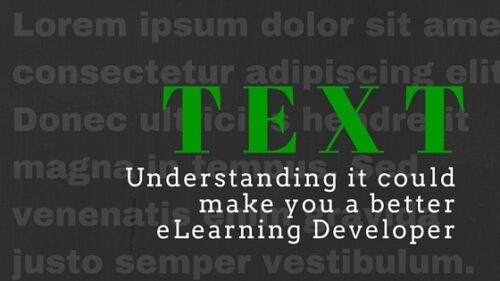What You Don’t Know about Text Limits Your eLearning Development
Text is a very interesting medium. But I don’t think we give it enough credit. Text is the starting point of every project. A simple .txt file can be read/imported into just about every software system and application that exists. HTML is the foundation of the internet we know today. And writing those .html files can be done in a simple text editor. Text a digital medium is a powerhouse.
The many uses of text are obvious but let’s review a few. We write down our thoughts using text in journals. We blog our ideas using text. Movies begin as scripts using text. Products are described and sold to us using text. It’s the fastest way to express ideas and have those ideas consumed and potentially understood. Because everyone knows how to read and write text. Some better than others, but quality aside for now. I have no data but I would argue that text is the most used medium.
A recent conversation on blab.im got me thinking about text because Anthony Altieri mentioned a few text editors as his favorite tools for creating learning content. This was intriguing to hear. I understood where he was coming from, but also know that so many eLearning developers lack the basic understanding of text.†Or maybe it’s the intermediate level of understanding that is required? I’m not sure. But I do know that most don’t remember a time before WYSIWYG. And definitely not a time before browser based text editors with formatting capabilities. †Let’s start with the basics and I’ll look to this blog’s audience to continue the conversation and discover how important text may or may not be.
The Simple Text File .txt
In the digital world the most common text file format is not .doc. Text in its purest form is saved in the simple, yet handy, .txt format. You may have heard your geeky programmer friends refer to it as a “flatfile”. And at this point I’ll confess that it can get much more complicated than our purposes require. If you want to deep dive into the nuances of text files, text formats, and plain text, I’ll direct you to the wikipedia entry here.
In our work text files come in handy for transferring data from one system to the next, or storing scoring, and other user data on their drives or other external system. Text files hold no formatting. These days imported text files are always treated to some sort of formatting or other conversion process. You may never see plain text in all of yours as an elearning developer, but you would be doing yourself a favor to learn more about this powerful and underutilized file format.
The Lowly Text Editor
Text editors are the very plain uninteresting applications that come preloaded on every computer. You may have used a text editor thinking it could do the things MS Word can do. But shut it down on discovering how few features are available. But those who use text editors on a regular basis love how fast they load, and how responsive they are. †The simplicity is what makes them so powerful if you learn to use them effectively.
For a long list of text editors check out this page. You will likely recognize notepad and textedit. I only recognized 3 or 4 others from the list.
HTML: Hyper TEXT Markup Language
Most non-techie types would probably be shocked to know that the entire internet is built on a simple text based protocol. There is more to understanding HTML than merely understanding how to use text. However, it’s a lot more accessible than trying to communicate with ones and zeros. HTML is text based and uses tags to describe how content should be displayed within the browser. But I’m certainly not the expert on all of technical details of HTML.
Wikipedia explains HTML elements this way:
HTML elements form the building blocks of HTML pages. HTML allows images and other objects to be embedded and it can be used to createinteractive forms. It provides a means to create structured documents by denoting structural semantics for text such as headings, paragraphs, lists,links, quotes and other items. HTML elements are delineated by tags, written using angle brackets. Tags such as
<img />and<input />introduce content into the page directly. Others such as<p>...</p>surround and provide information about document text and may include other tags as sub-elements. Browsers do not display the HTML tags, but use them to interpret the content of the page.
That may not mean anything to you. But if it does, you’ll know if you need to learn more or not. Over the years rapid development tools with wysiwyg editors have mostly removed†the need for understanding web pages at this level. But like anything else, a little extra knowledge can go a long way.
As an eLearning professional, should you get familiar with a text editor? I would say absolutely. But how deeply you dive into it is the next question. You can greatly increase your development time even if you use an authoring tool. Most authoring tools now export to an HTML5 format. And knowing how to view that output in a text editor will come in handy some day. I can almost guarantee it.






